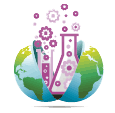 Harmful Substances and Hazardous Waste
Harmful Substances and Hazardous Waste
Introduction
Chemicals are an integral part of everyday life with over 100,000 different substances in use. Industries producing and using these substances have an enormous impact on employment, trade and economic growth worldwide. There is hardly any industry where chemical substances are not implicated and there is no single economic sector where chemicals do not play an important role.
However, besides the benefits from chemicals it is increasingly recognized that they also have the potential to adversely impact human health and the environment if not managed properly. The health related effects range from acute poisoning to long term effects, such as cancers, birth defects, neurological disorders, and hormone-disruption.
Environmental effects range from effects on sensitive species / ecosystems, to large scale issues such as eutrophication of water bodies and stratospheric ozone depletion. Chemicals contamination is wide spread both on land and in water. People are exposed through occupational activities as well as in daily life through intake of contaminated drinking water, ingestion of contaminated food (e.g. fish contaminated with mercury, DDT and/or PCBs), inhalation of polluted air (outdoor as well as indoor), and through direct skin contact.
Meanwhile, the continued growth pattern of global production, trade and use of chemicals exerts an increasing chemicals management burden on the developing countries and those with economies in transition that have the least capacities to deal with such complex challenges. By 2020, developing countries are expected to lead the world in growth rate for high volume industrial chemicals, increasing their share of world chemicals production to 31 %. Chemical consumption in developing countries is likewise growing much faster than in developed countries and could account for a third of global consumption by 2020. Sustainable use of chemicals is an issue that needs urgent attention in these countries not to endanger ecosystems, environmental resources, and the livelihoods and health of future generations.
Objective
To minimize the impact of harmful substances and hazardous waste on the environment and human beings.
While chemicals are major contributors to national economies, they require sound management throughout their life cycle. Otherwise, in addition to the benefits, they will pose significant risks to human health and the environment and result in significant costs to national economies. There is an established link between the condition of poverty and increased risks of exposure to toxic and hazardous chemicals, as they affect predominantly the poor who routinely face unacceptable high risk of poisoning because of their occupation, living location and lack of knowledge of proper chemicals management.
The global economy is also seeing a rapid increase in generation of hazardous wastes. These wastes not only pose risks and hazards because of their nature but also have the potential to contaminate large quantities of otherwise non-hazardous wastes if allowed to get mixed. Thus proper segregation, treatment and disposal of hazardous wastes are of paramount importance.
Although most of the conventional hazardous wastes are produced in industrial and manufacturing operations, significant amounts are also generated in non-industrial sectors, including sludge from waste water treatment plants, waste oils, and waste batteries.



